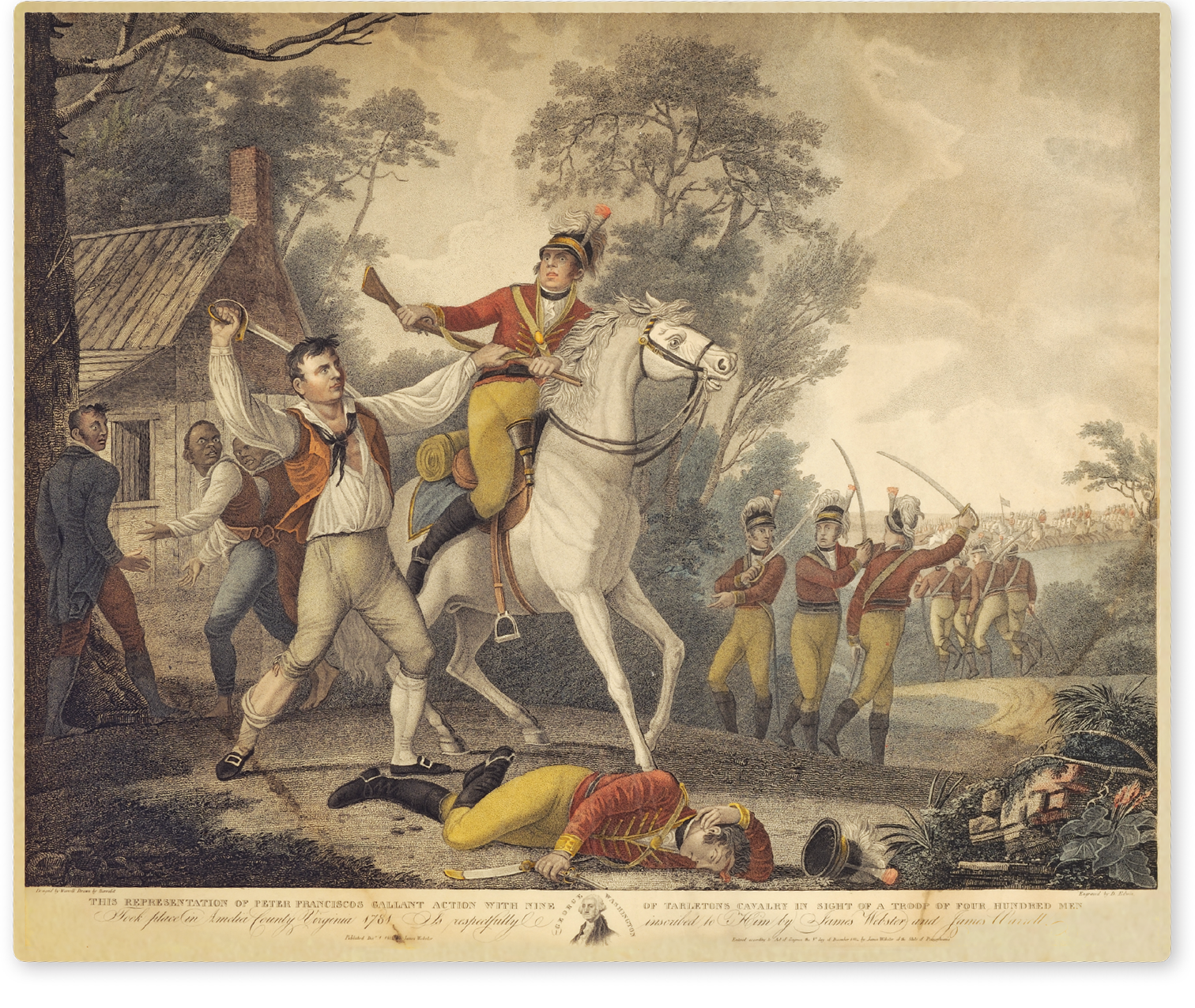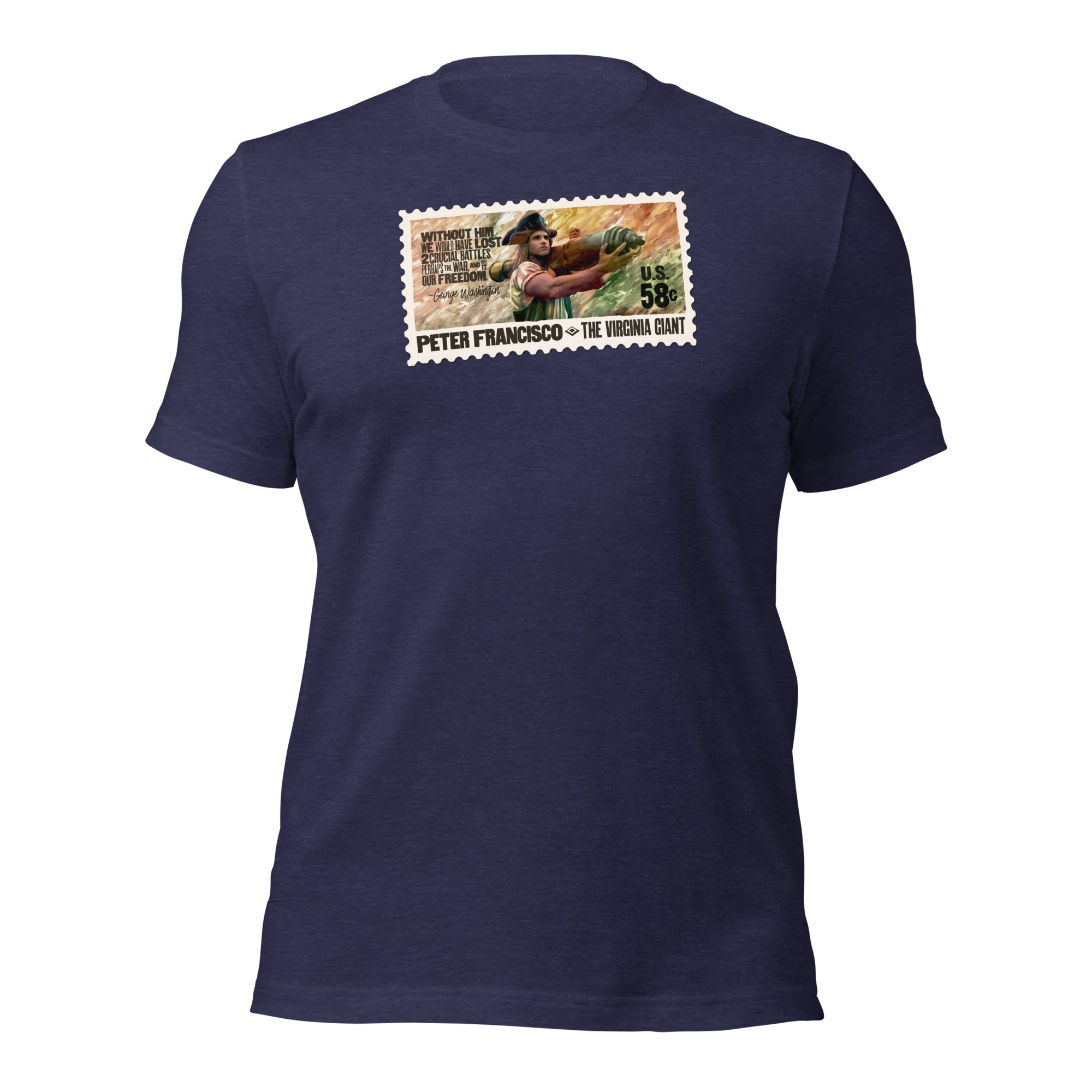LUSO
Peter Francisco
(July 9, 1760 – January 16, 1831)
LUSO
Peter Francisco
(July 9, 1760 – January 16, 1831)
PETER "PEDRO" FRANCISCO
Pedro Francisco was born on July 9th, 1760 in Porto Judeu on Terceira Island in the Azores. Unfortunately, in real life, he never knew where he was from, but a professor from the University of Virginia found the birth record in 1960 when he was doing research in the Azores for other studies.
Peter would later recount that he was kidnapped on the Day of Pentecost from an island, and then Virginia documents record that he was found on June 23, 1765 in City Point (now Hopewell, VA). There is a monument in front of city hall in honor of where young Pedro (later changed to Peter) was found in Virginia and the historic marker in town calls him George Washington’s “One Man Army”. Francisco was in most of the major battles of the Northern and Southern campaign during the Revolution. He fought for a total of five years… from the beginning to the very end.
The battle scenes in the miniseries are based on eye witness accounts and historic documents about Peter’s heroic actions. He was wounded six times and left for dead twice.


The Portuguese-American communities in New England have been preserving Peter’s legacy for over 50 years by building monuments in his honor, naming parks after him, and even giving out the Peter Francisco Award every five years. The first recipient was John F. Kennedy.
Today, five monuments stand in Peter Francisco’s honor, four states observe Peter Francisco Day on March 15th, and the US Postal service enshrined him on a stamp in 1976. Two of the five monuments refer to him as “Hercules”. There are several museums in Virginia and North Carolina that have artifacts on display that were owned by Peter, and his home, called Locust Grove, has been a registered national historic site in Dillwyn, Virginia since 1972. A portrait painting of Peter hangs in the Virginia Capitol building right next to the Speaker of the House’s office door.
Peter lived a long life and was serving in the Virginia Senate when he passed away at the age of 71 on January 16th, 1831. The Virginia government shut down for a day to mourn the loss of a Revolutionary hero, and they paid for his funeral. The Richmond Times reported this was the largest funeral procession Virginia had ever seen. He is buried in a famous cemetery in downtown Richmond, Virginia.
Peter Francisco
Life Events
1760 – born July 9th and raised in Azores
1765 - kidnapped at age 5; found on a dock in Hopewell, VA
1765 - Judge Anthony Winston, Patrick Henry’s uncle, purchased him as an indentured servant
1775 - inspired to fight by Patrick Henry’s famous speech
1776 - joined the 10th VA Regiment; stood 6’6”; weighed 260 lbs
1777 - wounded at the Battle of Brandywine; become close friend of Marquis de Lafayette while recuperating
1777 - Hospitalized at Valley Forge
1778 - wounded at Monmouth, NJ; the musket ball remained lodged in his body the rest of his life
1779 - captured the flag at Stony Point, NY after receiving a 9” bayonet wound
1780 - carried an 1100 lb cannon off the battlefield in Camden, SC
1781 - George Washington had a 6’ broadsword forged for Peter just before the Battle of Guilford Courthouse; Peter killed 11 British before being wounded and left for dead
1781 - evaded 400 of Tarleton’s men
1781 – was with Marquis de Lafayette in Yorktown for the British Surrender
1831 - Peter was buried with full military honors in Shockoe Hill Cemetery in Richmond.
PETER "PEDRO" FRANCISCO
Pedro Francisco was born on July 9th, 1760 in Porto Judeu on Terceira Island in the Azores. Unfortunately, in real life, he never knew where he was from, but a professor from the University of Virginia found the birth record in 1960 when he was doing research in the Azores for other studies.
Peter would later recount that he was kidnapped on the Day of Pentecost from an island, and then Virginia documents record that he was found on June 23, 1765 in City Point (now Hopewell, VA). There is a monument in front of city hall in honor of where young Pedro (later changed to Peter) was found in Virginia and the historic marker in town calls him George Washington’s “One Man Army”. Francisco was in most of the major battles of the Northern and Southern campaign during the Revolution. He fought for a total of five years… from the beginning to the very end.
The battle scenes in the miniseries are based on eye witness accounts and historic documents about Peter’s heroic actions. He was wounded six times and left for dead twice.

The Portuguese-American communities in New England have been preserving Peter’s legacy for over 50 years by building monuments in his honor, naming parks after him, and even giving out the Peter Francisco Award every five years. The first recipient was John F. Kennedy.

Today, five monuments stand in Peter Francisco’s honor, four states observe Peter Francisco Day on March 15th, and the US Postal service enshrined him on a stamp in 1976. Two of the five monuments refer to him as “Hercules”. There are several museums in Virginia and North Carolina that have artifacts on display that were owned by Peter, and his home, called Locust Grove, has been a registered national historic site in Dillwyn, Virginia since 1972. A portrait painting of Peter hangs in the Virginia Capitol building right next to the Speaker of the House’s office door.
Peter lived a long life and was serving in the Virginia Senate when he passed away at the age of 71 on January 16th, 1831. The Virginia government shut down for a day to mourn the loss of a Revolutionary hero, and they paid for his funeral. The Richmond Times reported this was the largest funeral procession Virginia had ever seen. He is buried in a famous cemetery in downtown Richmond, Virginia.
Peter Francisco
Life Events
1760 – born July 9th and raised in Azores
1765 - kidnapped at age 5; found on a dock in Hopewell, VA
1765 - Judge Anthony Winston, Patrick Henry’s uncle, purchased him as an indentured servant
1775 - inspired to fight by Patrick Henry’s famous speech
1776 - joined the 10th VA Regiment; stood 6’6”; weighed 260 lbs
1777 - wounded at the Battle of Brandywine; become close friend of Marquis de Lafayette while recuperating
1777 - Hospitalized at Valley Forge
1778 - wounded at Monmouth, NJ; the musket ball remained lodged in his body the rest of his life
1779 - captured the flag at Stony Point, NY after receiving a 9” bayonet wound
1780 - carried an 1100 lb cannon off the battlefield in Camden, SC
1781 - George Washington had a 6’ broadsword forged for Peter just before the Battle of Guilford Courthouse; Peter killed 11 British before being wounded and left for dead
1781 - evaded 400 of Tarleton’s men
1781 – was with Marquis de Lafayette in Yorktown for the British Surrender
1831 - Peter was buried with full military honors in Shockoe Hill Cemetery in Richmond.
“Without him, we would have lost two crucial battles, perhaps the War, and with it our freedom.
He was truly a One-Man Army.”
-George Washington
SHOP LATEST
WATCH LATEST
OWN THE LATEST




